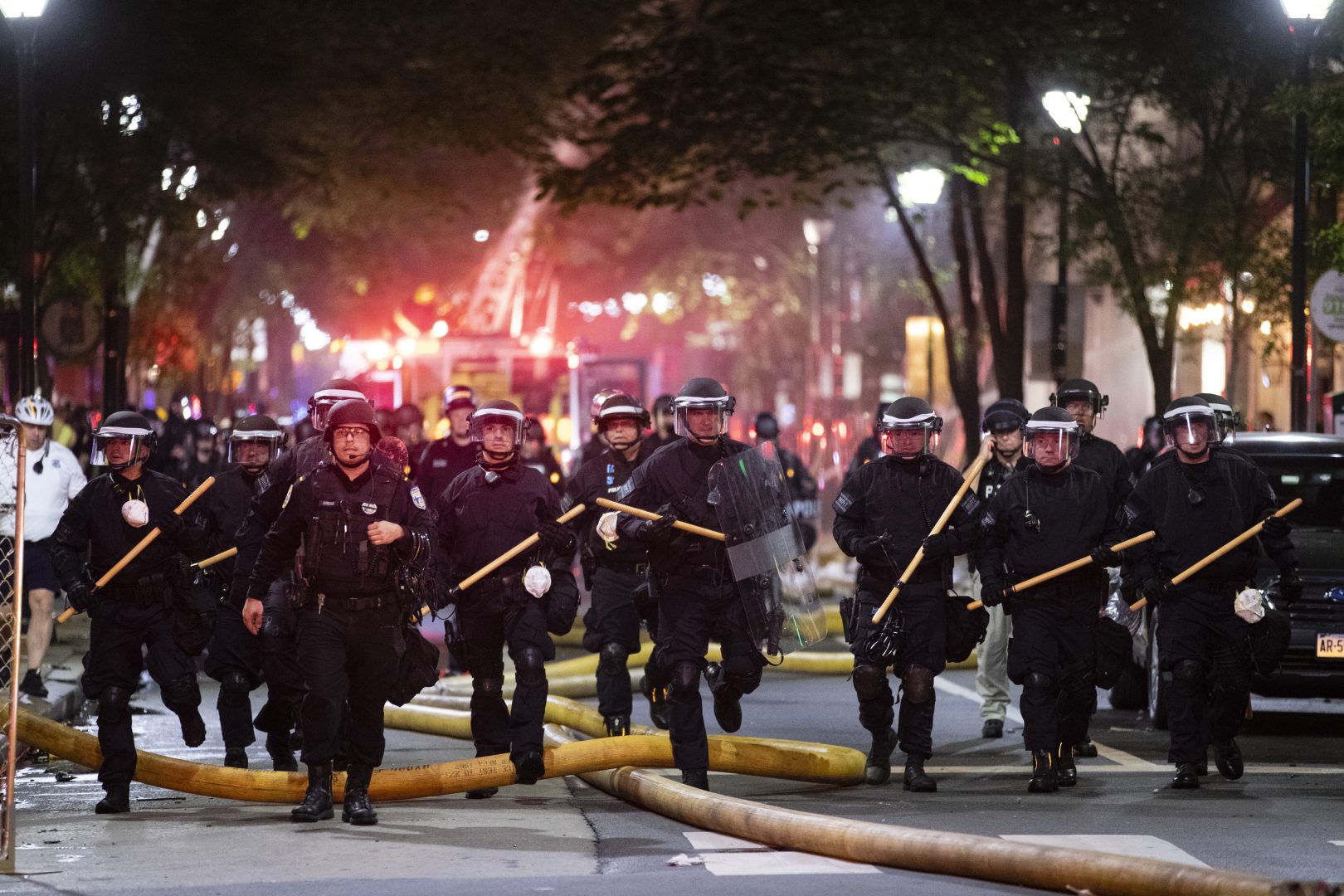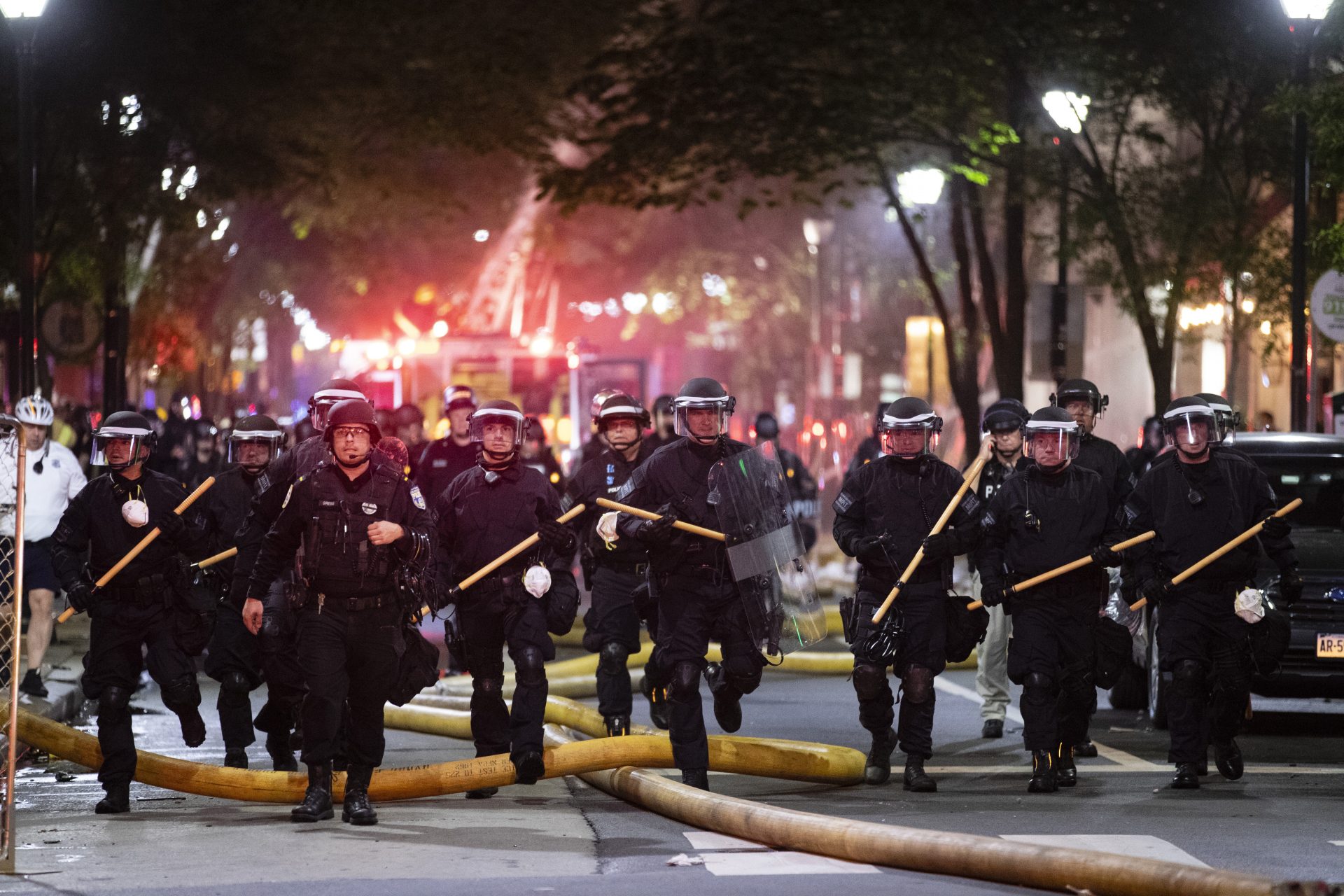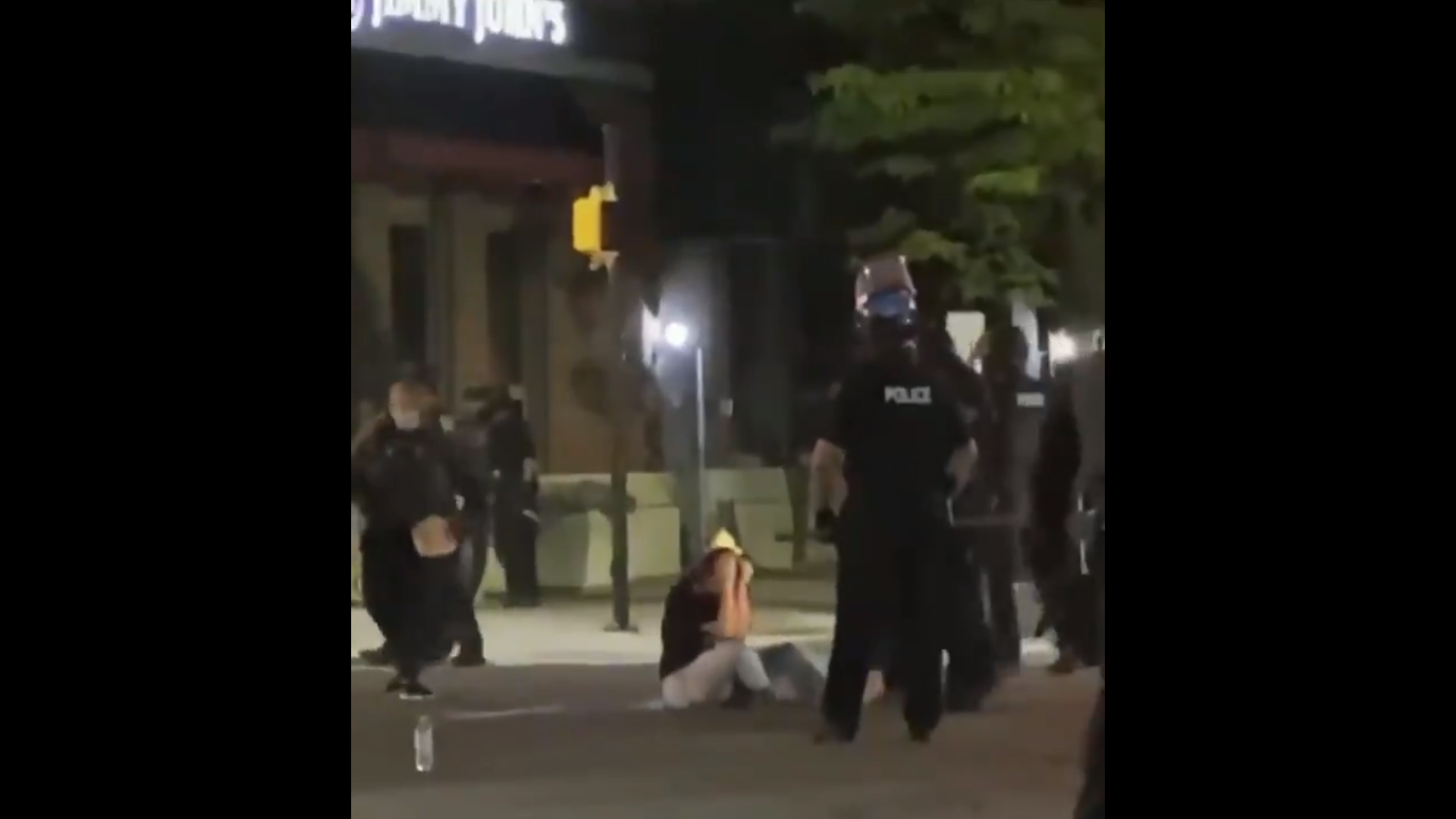
Police push down a street Saturday, May 30, 2020, in Philadelphia, during a protest over the death of George Floyd.
Matt Rourke / AP Photo

Police push down a street Saturday, May 30, 2020, in Philadelphia, during a protest over the death of George Floyd.
Matt Rourke / AP Photo

Matt Rourke / AP Photo
Police push down a street Saturday, May 30, 2020, in Philadelphia, during a protest over the death of George Floyd.

Matt Rourke / AP Photo
Police push down a street Saturday, May 30, 2020, in Philadelphia, during a protest over the death of George Floyd, a black man who was in police custody in Minneapolis. Floyd died after being restrained by Minneapolis police officers on Memorial Day. (AP Photo/Matt Rourke)
From every corner of America, protesters this past week marched against police departments’ wide use of excessive force. And though the protests – and eventual riots – were sparked by a Minneapolis police officer’s killing of George Floyd (an unarmed black man suspected of passing a counterfeit bill at a bodega), they illustrate the pent up feelings of communities of color whose members say they consistently are treated unfairly by law enforcement.
All of this is framed against three recent events:
First, the coronavirus pandemic, where communities of color – primarily Hispanic and Black – have been disproportionately affected by both the economic hardships of the coronavirus shutdowns, but more importantly the health impacts – contracting COVID-19 and dying at higher incidences compared to white populations.
Second, Ahmaud Arbery’s killing, where three white men are charged with killing a 25-year-old African American without provocation in a South Georgia suburb. The police didn’t arrest or charge the men with murder until months later, after the release of a cellphone video that documented the brutal, unprovoked killing.
Third, the Central Park police call, where a white woman was caught on video calling 9-1-1 and, with feigned panic in her voice, saying an “African American man” was threatening her. The man asked her to leash her dog in a part of the park where that’s required. Her response was to seek a violent police intervention.
Three powerful backdrops fueled outrage that was already simmering.
Who’s to blame that protests in some cities turned into riots and looting? Lawmakers and government officials, such as U.S. Attorney General William Barr, blamed “outsiders” intent on committing violence (not the case in Minneapolis at all). Others blamed police tactics. But what was clear in the images beamed into our homes this weekend is that once protests got heated, police equipped like soldiers responded with force.
Why did police respond so aggressively in Pennsylvania and across the country? Three cities in Pennsylvania – Philadelphia, Pittsburgh and Harrisburg – all saw protests escalate. In Harrisburg, city police and capitol guards arrived at unarmed peaceful protests dressed in full riot gear. At the beginning of the protests, a WITF reporter mistook a police officer for a Marine. The officer was dressed in fatigues and armed with a shotgun.
By comparison, at recent ReOpen PA protests, where largely white crowds gathered to denounce the governor’s decision to close businesses, there was no similar police presence, despite some participants openly carrying firearms.
“I’ve been to both of the reopen protests where several hundred people gathered with handguns and long guns and I never saw police respond in anything like that way,” said WITF’s Brett Sholtis.
Over the weekend, the media’s coverage of the protests also captured on camera many of the aggressive and violent tactics police have used against communities of color for decades. In Erie, for example, a Twitter user caught a police officer kicking a sitting woman to her back when she was already subdued.
The responses from political leaders on both sides of the partisan divide have been fairly predictable, placing blame on other groups rather than addressing the heart of the issue: America’s race problem.
Pittsburgh Mayor Bill Peduto, without citing any evidence, said that the riots in his city were caused by Antifa-like groups (a day later, police tried to arrest a 20-year-old alleged to have helped turn the rally there violent by damaging a police car). NYC Mayor Bill deBlasio downplayed the anger of protesters and said that some of them should have gotten out of the way of police cars barreling through barricades into protesters.
But probably the most divisive response came from President Trump, who took to Twitter to say looters would be shot, declare Antifa a domestic terrorist group and then disparage Democratic mayors for not calling in the national guard to stop protests.
These protests-turned-riots are occuring in cities that have long had problems with over-policing of minor crimes and under-policing of violent crimes in communities of color. They house a population of black and brown people who still face the backlash of policies enacted during a tough-on-crime era to blatantly target them. And they also are home to communities that are most ravaged economically by over-incarceration and underfunding of public programs.
And until those concerns are largely addressed, it’s hard to imagine not seeing more of these protests in the future. – Joseph Darius Jaafari

Screenshot from video
Hannah Silbaugh, 21, attended a protest in Erie on Saturday, May 30, 2020. A video of her being struck by a police officer has gained national attention. (Screenshot from video)
The kick seen ‘round the world: Plenty of protest videos went viral over the weekend, including one of an Erie woman, sitting on the ground with her hands over her face, who is seen being kicked over by a police officer. PA Post’s Ed Mahon spoke with her and wrote this story. For local coverage, see this piece from GoErie.com.
What went down in Harrisburg: The protest march in Pennsylvania’s capital turned violent on Saturday. Why? According to city officials, police held back until they were attacked. WITF’s Brett Sholtis was there. Down the road in Lancaster on Sunday, the mayor intervened to de-escalate tensions between marchers and police there. Pittsburgh saw a mostly peaceful day of protests on Sunday, as did Allentown, and Reading, where PA Post’s Anthony Orozco live-tweeted the day’s events.
Following orders? Aggressive police tactics got so much attention this weekend, in part, because reporters were deliberate targets of some law enforcement officers. On live TV in Minneapolis, police detained a CNN reporter and field producers. In Louisville, Kentucky, an unprovoked police officer shot rubber bullets at a reporter and her photographer. In Brooklyn, police arrested a Huffington Post reporter. A VICE News reporter identified himself as press, got on his stomach but continued to be pepper sprayed. Linda Tirado, a freelance multimedia journalist, was hit by a “non-lethal” round fired by police in Minneapolis and lost the vision in one of her eyes as a result. Our WHYY colleague Avi Wolfman-Arent was briefly detained on Sunday.
Tragic ironies: The Black community is one of the hardest hit by the coronavirus. And even though that disparity has roots in poverty and racism, public health officials worry it will only get worse for the community as the protests continue to bring in large crowds and thousands of people. In Philadelphia, a part of town that struggled for years to rebuild its economy, was the scene of some of the worst of the rioting over the weekend. “Seeing decades of investment, of community planning, of support from grant-making agencies, and seeing so much of that great work literally be thrown away in the course of an afternoon is really devastating,” said Jabari Jones, president of the West Philadelphia Corridor Collaborative.
An oldie, but goodie: In 1962, James Baldwin, a Black gay man and one of the more prolific writers during the Civil Rights era, wrote about how white people needed to look inwards to understand the Black community’s struggles. The New Yorker this past weekend republished that essay, which rings just as true now as it did back then.
From the riots to the jail: For those who were arrested in NYC, police precincts can hold people for 40 hours before seeing a judge. If they can’t make bail, they are sent to Rikers Island. But one problem: we are still in a pandemic, and Rikers has the highest rate of COVID-19 infections in the state. VICE has that story.
America is broken: But it can be fixed – and it should be, wrote former California gov. Arnold Schwarzenegger. In a piece for The Atlantic, Schwarzenegger writes that when he arrived in America in 1968, he was ecstatic to come to a nation that launched men to the moon for the first time, but also found it distressing the police violence against protesters during the civil rights movement. Now, he writes, it feels like a moment that has come very full circle. “On Saturday, we watched brave astronauts launch into space once again. And once again, our streets are filled with protesters who are fighting a system that limits them.”
Further reading:
Kareem Abdul-Jabbar: Don’t understand the protests? What you’re seeing is people pushed to the edge
The Bulwark: Opinion: To Make Police Accountable, End Qualified Immunity. One conservative congressman says he will introduce a bill to do that.
The New Yorker: A Long Night With the Jail-Support Crew Outside One Police Plaza After Protests in New York
Minneapolis Star Tribune: The toll of our unrest: Scenes from the Twin Cities
End note:
From a Philadelphia Inquirer editorial published Sunday afternoon:
The statue of Frank Rizzo is perhaps the most blatant symbol of this city’s brutal police past. Protesters tried to topple the statue over the weekend and ended up defacing it.
It was one of the first things cleaned up on Sunday morning.
If Saturday night won’t lead to a dramatic shift in priorities, it’s hard to imagine that Philadelphia won’t go up in flames again.
The days of journalism’s one-way street of simply producing stories for the public have long been over. Now, it’s time to find better ways to interact with you and ensure we meet your high standards of what a credible media organization should be.